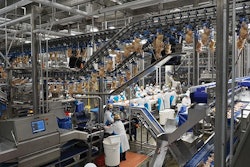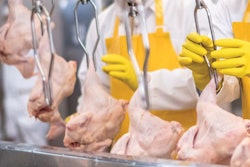
Ever increasing poultry processing line speeds make advanced weighing and sorting machinery a must for today’s poultry plants.
Modern weighing, grading and sorting systems eliminate the need for difficult, tedious manual operations as well as human biases. Advanced, automatic machinery and software offered by leading manufacturers increase accuracy of measurement and throughput while maintaining product quality.
WATT PoultryUSA surveyed seven poultry processing equipment manufacturers – Baader Group, Foodmate US Inc., JBT - Prime Equipment Group Inc., Marel Stork Poultry Processing B.V., Meyn Food Processing Technology B.V. , Staubli Corp. and Triangle Package Machinery Co.– to assess the state of the art for the machinery.
A key to poultry processing
Weighing and sorting solutions are already common in food processing around the world, but they are becoming more advanced as the technology powering the devices and the software processing the data steadily advance.
As in other areas of the plant, these devices serve to eliminate tedious positions that are difficult to consistently staff. The global outbreak of COVID-19, and the challenges it presents for processors, serves as another important motive for further automation of these tasks.
Furthermore, the equipment manufacturers argue modern plants wouldn’t function at the same speed, or with the same efficiency, without advanced weighing, sorting and grading machinery. These machines reduce waste, grade the quality of product while still on the processing line, control the size of pieces used in packaged and labeled products, capture useful processing data, and aid in transferring products from one line to another or from a line into a package.

Batching devices remove the need for workers to weigh and sort out pieces and prep them for packaging. (Courtesy Marel Stork Poultry Processing B.V.)
Advanced technology
In recent years, this class of machinery improved significantly by adding upgrades designed to enhance efficiency and speed up throughput. The largest advancements are the addition of more accurate and durable digital scales and the integration of analytics software within the devices. Today’s machinery is also made tougher and easier to clean and maintain than previous generations.
Modern machinery often uses three aspects, an infeed system, a dynamic weighing unit and a discharge unit. Phil Lamb, a product manager for Marel, said once a product is weighed, a batching algorithm determines where a product should go based on its size in order to create the best possible combination in a batch. Then, the product is discharged through a gate into a box, crate or takeaway belt before packing.
Paul van de Runstraat, a product manager with Meyn, and Meyn Chief Engineer Jan Willem Hagendoorn said other, inline devices use a camera that can assess the quality of a product by detecting any sort of damage, illness or other discrepancies. Advanced controllers can also help direct the flow of product that must be rehung or reworked, elsewhere. This software, which the manufacturers integrate throughout their machines, can display all relevant, actionable information to plant managers on a dashboard display.
Paul Sykes, managing director at Foodmate UK, and David McNeal, national account manager for Foodmate US, said the addition of user-friendly interfaces takes much of the difficulty out of operating automated weighing, grading and sorting system and permits greater knowledge of, and control over, the operation.
One manufacturer, Staubli, makes a range of four- and six-axis articulated robot arms designed for use in primary and secondary processing. The robotic systems are used to manipulate and transform food products for various applications at many stages of the process, including weighing and sorting as well and packing items into trays and pallets.

Some sorting devices integrate imaging technology and analytical software. (Courtesy Foodmate US Inc.)
Quantifying labor savings
The equipment manufacturers said under current operating conditions there really is no alternative to using automated systems for this purpose. The alternative, Baader CEO Oliver Hahn said, would be using a manual operation that would move slowly, take up excessive space in the plant and introduce inaccuracies into the operation.
Sykes and McNeal said modern weighing and transferring machines and grading machines can process up to 250 birds per minute. Moreover, they eliminate the need for people manually grading product and directing it to the right wrapping machine.
Lamb said the amount of labor savings depends on the amount of automation in the plant. Depending on the plant’s needs, a simpler grading machine could replace one to three workers. More integrated solutions can eliminate the need for workers handling this task.
“In most cases, the customer is saving labor, and on top of that, throughput increases, and give-away is minimized, which has a huge impact,” Lamb said.
There are some minor tradeoffs to using the machines, however. Hahn noted any machine is going to require maintenance, adjustments and proper operation to perform at an optimal level. Van de Runstraat and Heemskerk said accurately measuring the weight of a moving product is harder than a static product, which means inline weighing is not as accurate as weighing static objects by hand. However, no manual operation could work as quickly and effectively as a modern weighing device.
Use in the U.S. and around the world
Due to its advantages and necessity for some operations, the use of weighing, grading and sorting machines is already widespread in the U.S., Europe and elsewhere in the world.
Lamb said Marel’s products are widely used for weighing front halves into auto cut-up lines and debone lines. The company’s products are also used for sorting out tenders, breasts and butterfly cuts into 70-pound totes or into automatic vertical bagging machines for 10- to 20-pounds bags.
In Europe, line speeds can operate as quickly as 250 birds per minute, so the need for automation of weighing, grading and batching solutions is greater in that market. Lamb said that’s leading to higher demand for digitization and robotization of processes, too. Additionally, Van de Runstraat and Heemskerk said there is growing demand for high-accuracy weighing as early as possible in the process. That is because air-chilling is more prevalent in Europe and processors want their first weighing device positioned before chilling.
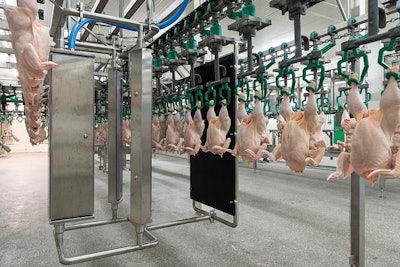
Imaging technology can be used in-line to inform sorting operations further ahead in processing. (Courtesy Meyn Food Processing Technology B.V. )
Weighing and sorting product spotlight
Major equipment manufacturers offer a range of machinery to aid in weighing, grading, sorting and batching in the poultry plant.
Baader
Belt Grader 1800 Series: Baader’s Belt Grader 1800 series includes of a feeding area, dynamic scale and distribution zone. The conveyor incorporates one modular belt to ensure efficiency in simple grading and sorting jobs at minimal osts. The Belt Grader series 1801 grades up to 160 pieces per minute on each lane, depending on the product type and accurate spacing between products.
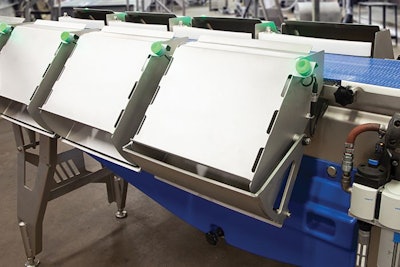
(Courtesy Baader Group)
Foodmate
TraySort: Foodmate’s TraySort is a camera-based system located in-line before the tray wrap machines. It uses advanced artificial intelligence software to identify and sort products in order to direct it to the correct wrapping machine to wrap that product.

(Courtesy Foodmate US Inc.)
JBT-Prime
MARS Efficiency Management Technology: JBT-Prime Equipment Group's MARS Efficiency Management Technology uses counters, weigh stations and diverters to weigh incoming product before a given process, and outgoing product after. It then creates reports in real time and by shift, with actionable data allowing instant measure of changes in process. It can be used for applications such as measuring yield performance, blending products from multiple lines and sorting incoming birds by size.
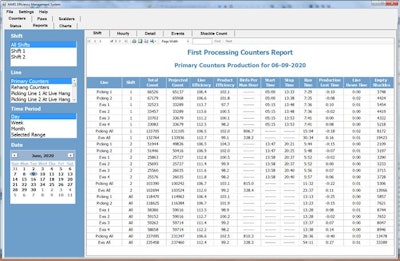
(Courtesy JBT - Prime Equipment Group Inc.)
Marel
Compact Grader: Marel’s Compact Grader is a solution designed for simple grading and batching. It works as part of a daily process or for temporary and season overflows. It combines strong yield, a small plant footprint and user-friendly design with a platform that provides accurate grading. The accompanying plug-and-play software includes more than 50 grading programs.

(Courtesy Marel Stork Poultry Processing B.V.)
Meyn
Carousel Rehanger M2.0: Meyn’s Carousel Rehanger is a reliable device designed to weigh whole birds and transfer them between two separate production lines, such as from the evisceration line to the chill line or from the chill line to the weighing line. It is built to provide a continuous process flow at high speeds throughout the processing plant.
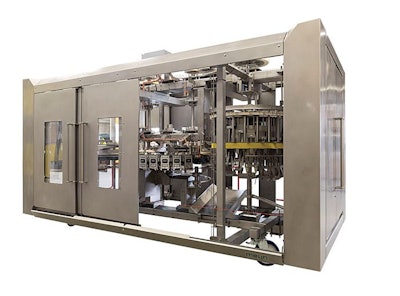
(Courtesy Meyn Food Processing Technology B.V. )
Staubli
TS2 HE: The Staubli TS2 HE is a four-axis robotic arm developed specifically for the food industry. It is designed for pick-and-place applications in food processing and made to stand up to the rigorous demands of a meat processing plant. The machinery meets the hygienic requirements of the food industry, too, and can withstand daily wash-down as well as liquid immersion.
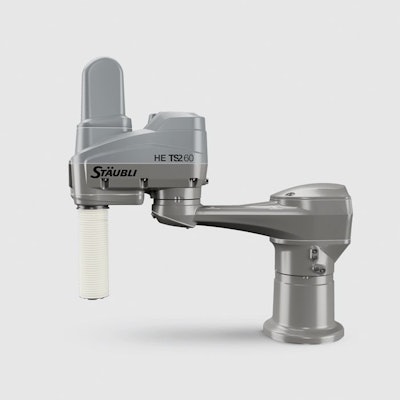
(Courtesy Staubli Corp.)
Triangle Package Machinery
Model A612BF Belt-Fed Weigher: Triangle Package Machinery Model A612BF Belt-Fed Weigher uses belts instead of vibratory feeders and a belt discharge design rather than a hopper. It uses twelve six-foot by six-foot buckets, and is used for weighing fresh protein, either bone-in or boneless, and marinated proteins in cubes, chunks and shreds.
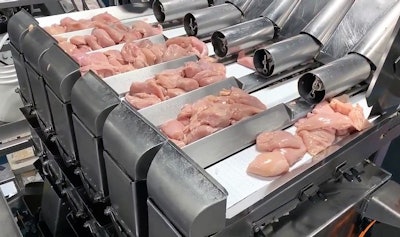
(Courtesy Triangle Package Machinery Co.)


